
November 3, 2023
The importance of mathematics in students’ academic and professionalpaths keeps growing worldwide. Institutions provide courses in various subjects - like data science and economics - which require a minimum level of maths proficiency for success, are very attractive for international students and are in high demand.
However, assessing the knowledge and skills of international applicants with diverse qualifications can be challenging. Current evaluation methods are resource and time-consuming for institutions and applicants. This means universities and colleges risk losing students with high potential to succeed in these programs. Admissions offices need a streamlined and flexible option that ensures fairness.
That’s why Ecctis, a trusted authority in international education and qualifications, has partnered with OMPT to bring a leading admissions solution in Europe to the UK. Together, we co-hosted a webinar discussing the global secondary mathematics landscape and introduced how admissions offices can streamline their maths proficiency assessment process with online maths admissions exams. Moreover, Kasia Malarek, Admissions Officer at Amsterdam University College, gave us her testimonial to explore how this institution uses OMPT in practice.
If you missed this webinar or want to refresh its content, you can learn the main takeaways from this session in this blog post.
The importance of mathematics in students’ academic and professionalpaths keeps growing worldwide. Institutions provide courses in various subjects - like data science and economics - which require a minimum level of maths proficiency for success, are very attractive for international students and are in high demand.
However, assessing the knowledge and skills of international applicants with diverse qualifications can be challenging. Current evaluation methods are resource and time-consuming for institutions and applicants. This means universities and colleges risk losing students with high potential to succeed in these programs. Admissions offices need a streamlined and flexible option that ensures fairness.
That’s why Ecctis, a trusted authority in international education and qualifications, has partnered with OMPT to bring a leading admissions solution in Europe to the UK. Together, we co-hosted a webinar discussing the global secondary mathematics landscape and introduced how admissions offices can streamline their maths proficiency assessment process with online maths admissions exams. Moreover, Kasia Malarek, Admissions Officer at Amsterdam University College, gave us her testimonial to explore how this institution uses OMPT in practice.
If you missed this webinar or want to refresh its content, you can learn the main takeaways from this session in this blog post.
The level of specialisation in mathematics during upper-secondary education can vary greatly, as you can see on this scale.
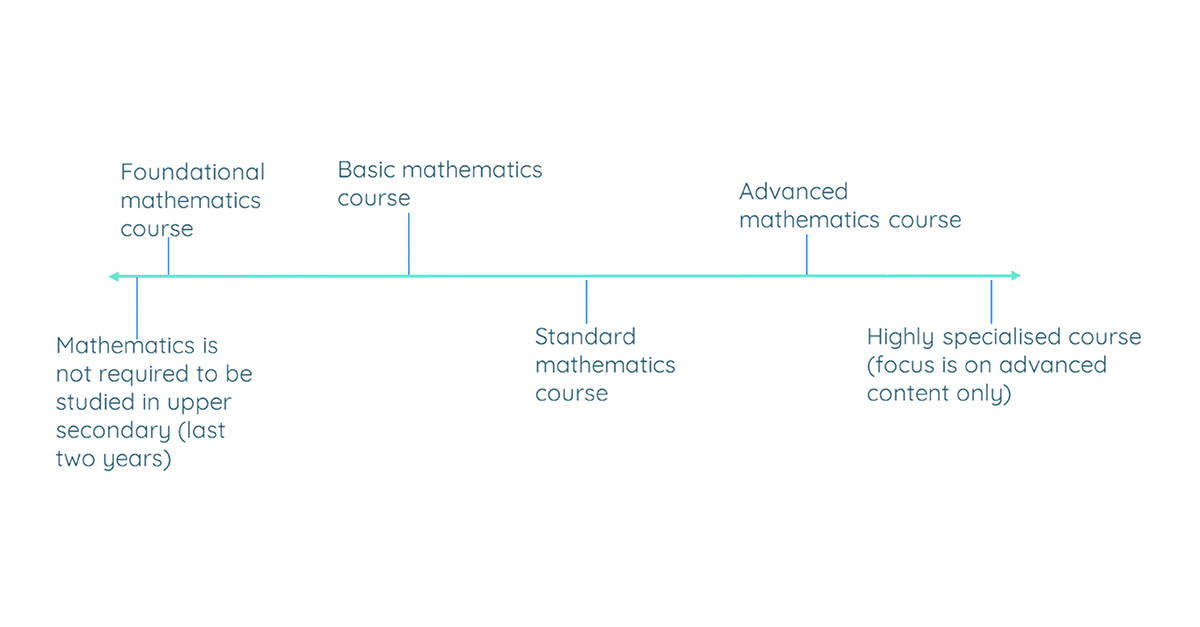
At one end of the scale, mathematics might not be a required subject, particularly in the last two years. For others, it might be a foundational or basic-level subject. Moving towards the other end of the scale, we see advanced courses that prepare students for mathematics in higher education or STEM-related lessons. At the very end, students might have taken a highly specialised course covering only advanced content.
The graph below displays the skills that are commonly included in different international mathematics curricula. The main skills, often included in the curricula, are represented in dark blue and are the largest ones. They found that most curricula include communication, problem-solving skills, reasoning, interpretation, understanding and application, and the use of tools.
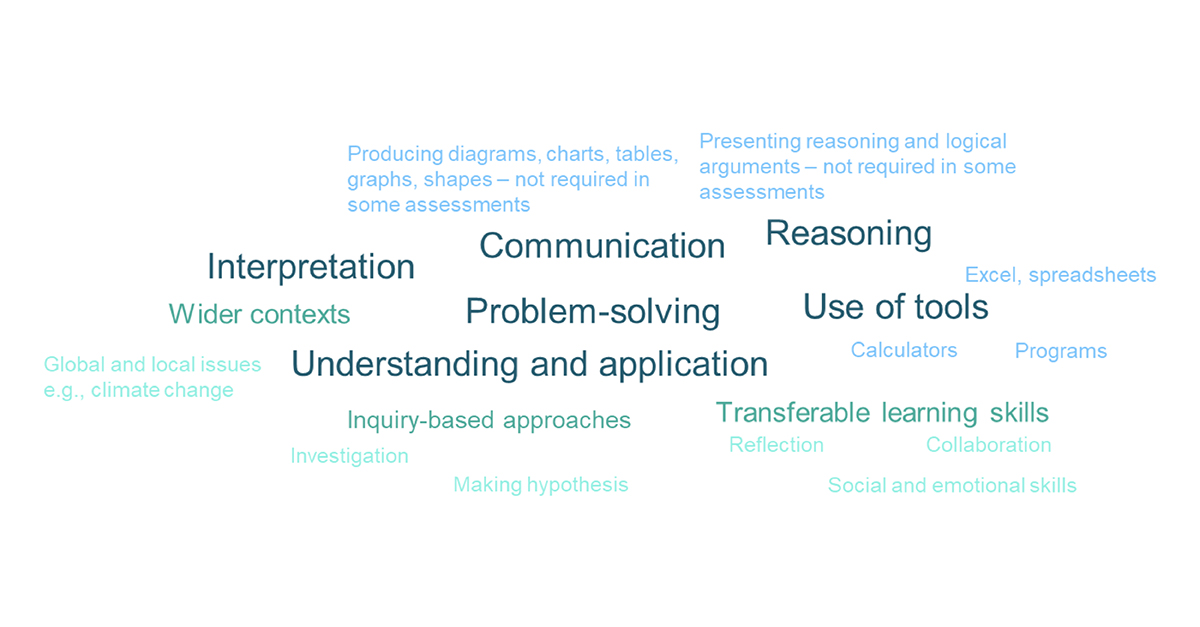
In addition, represented in green, there are skills which were present in some but not all of the curricula: broader contexts, inquiry-based approaches, and transferable learning skills. Some curricula might explore global and local issues, such as climate change, embedded in their mathematics education.
Complementing the main skills, some related sub-skills have been highlighted in light blue. Although the primary skill is communication, sub-skills (such as producing diagrams, graphs, and tables) may not be required for the assessment. Similarly, depending on the assessment format, presenting reasoning and logical arguments might not be necessary for the assignments.
The use of tools is also subject to variation. While most programs might expect students to use calculators, some may require Excel and spreadsheets, while others may require programs like Python. Therefore, while the primary skills are similar, the sub-skills related to them can differ depending on the assessment requirements.
These radar diagrams depict the multiple topics a standard-level course might cover, with the numbers indicating depth and complexity. However, there is variation in the focus of each course. For instance, some standard-level courses, such as those in Ontario or Australia (Victoria), may not include calculus.
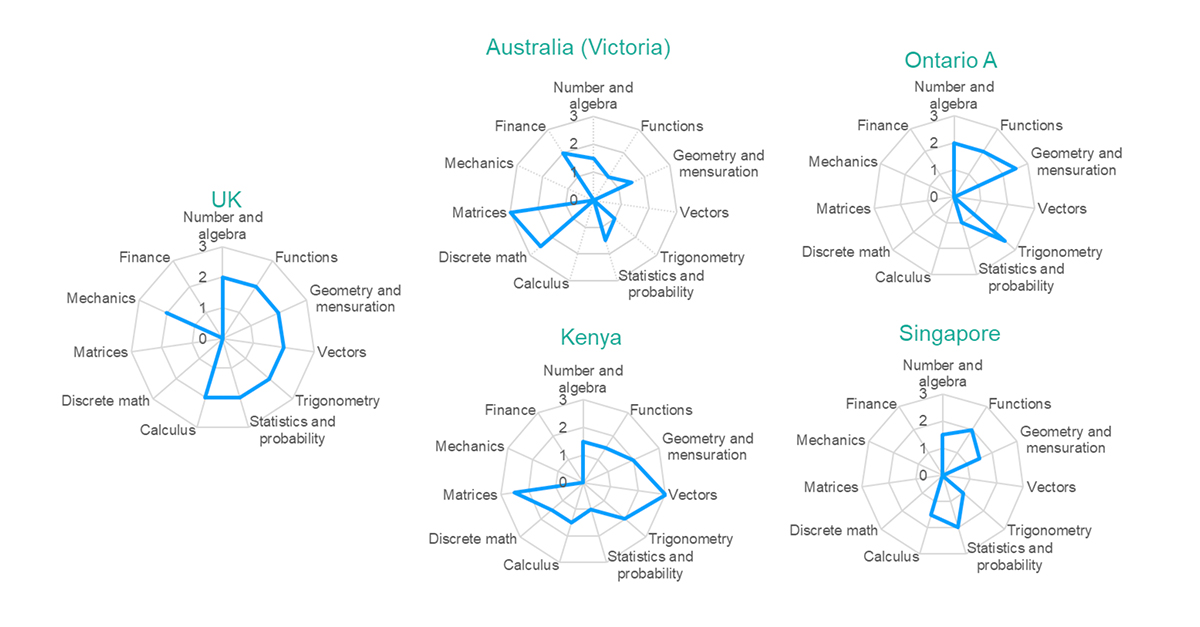
Some courses may have less emphasis on statistics and probability, which are thoroughly covered in the UK curriculum but not necessarily in others.Different countries may prioritise various topics in their curriculum. For instance, some countries may include matrices or more discrete maths in their syllabus. Interestingly, the UK focuses on mechanics while other countries do not or require students to take an advanced course to study mechanics.
In the following image, we see courses classified as advanced-level. We can observe some similarities among them, such as the likelihood of containing vectors and calculus. And they may vary in the depth they cover in statistics and probability.
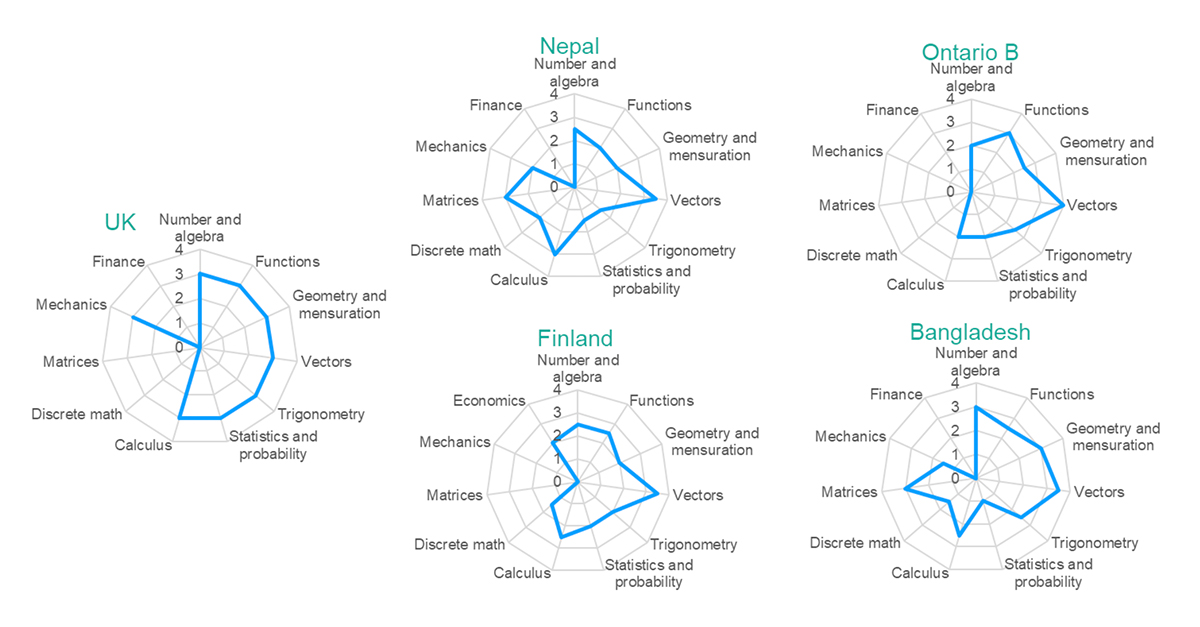
There are two different educational paths to consider when assessing students:
One evaluation: In one approach, students may complete their upper secondary education and gain access to higher education, such as with the UK A levels.
Two evaluations: In other curricula, these assessments are divided into two parts. A high school assessment may result in a high school certificate complemented by a university admission exam, such as the SAT.
Mathematics assessments can vary significantly, including their structure, format, question types, and difficulty levels.
In upper-secondary mathematics, there are often three types of assessments:
External examinations: They are organised by awarding organisations. Some examples are the A levels in the UK or the Certificate of Secondary Education in Kenya.
Internal examinations: On the other hand, internal assessments are evaluated by teachers in schools, such as the Ontario Secondary School Diploma.
Combination: Some curricula combine external and internal assessments, like the IB DP.
There are also differences in terminal and continuous assessment:
Terminal assessment: It takes place at the end of the course after the material has been studied, In the UK context, they do a terminal assessment.
Continuous assessment: In contrast, other systems choose an ongoing evaluation during the course, which might be done internally. One example is the UAE.
Combination: In other areas, they combine these possibilities, like with the Ontario Secondary School Diploma.
Question types on exams can be classified as either free response or non-free response.
Free response: Students are required to provide a complete answer and show their work. In the UK, free-response questions are common.
Non-free response: On the other hand, non-free response questions may require students to select a solution, such as multiple-choice questions. At this end of the spectrum, some university maths admission tests use this format, such as the Em-SAT and the SAT Math Test.
Combination: In some cases, exams may include both question types, as seen in the AP (Advanced Placement) exam.
Mathematics assessments can vary in their level of difficulty and complexity, and several factors can influence this. These factors include:
1) Item demand: The proportion of questions that target more challenging skills and content.
2) Threshold requirements: The minimum score or grade that a student needs to achieve and what they need to do to reach that level.
3) Marking: How the assessment is scored and the results are interpreted.
4) Time constraints: If there is a restricted time limit for the assessment, this can add to the level of demand.
5) Optional questions: If students can choose which questions to answer, it can also affect the difficulty.
Adam Smallwood (Head of Partnerships at OMPT) explained how these exams assist admissions offices in bridging the gap between different curricula and efficiently assessing maths readiness.
OMPT is specialised in digital maths testing for university admissions. It offers students a safe and proctored way to take tests from anywhere and at any time. OMPT is the leading provider of such services in the Netherlands, where 40% of first-year students are international. It provides a comprehensive online solution for testing mathematics for admission, testing over 3,000 students yearly.
Last year, more than 100 countries were represented by OMPT test-takers. Typically, these test-takers lack equivalency due to misalignment in their high-school curricula. In the past, such test-takers would have been rejected by universities or even asked to travel to their destination country to take an on-site exam, which added an overwhelming financial barrier to their application process. OMPT works with universities that used to conduct their own online tests, but it was unsustainable due to the administrative burden and insufficient security.
OMPT follows Bloom’s taxonomy, ensuring that they meet the highest educational standards and measure what they should. Moreover, OMPT works closely with institutions such as the University of Amsterdam, Maastricht University, and the Erasmus School of Economics to co-design our tests. During the test creation process, our team of mathematicians, educators, and education scientists collaborate with admissions officers and teachers. This approach enables us to deliver the best tests that help institutions identify students who fit their programs well. OMPT can also be used as a selective test for oversubscribed courses seeking to attract the best students.
Importantly, institutions also have complete freedom to set their own passing grade, the number of attempts permitted and the admission deadline. We can also offer advice based on the experiences of our community of universities. This is helpful as, of course, approaches vary depending on the particular demands of the study program and the university in general. OMPT can be used for multiple program types.
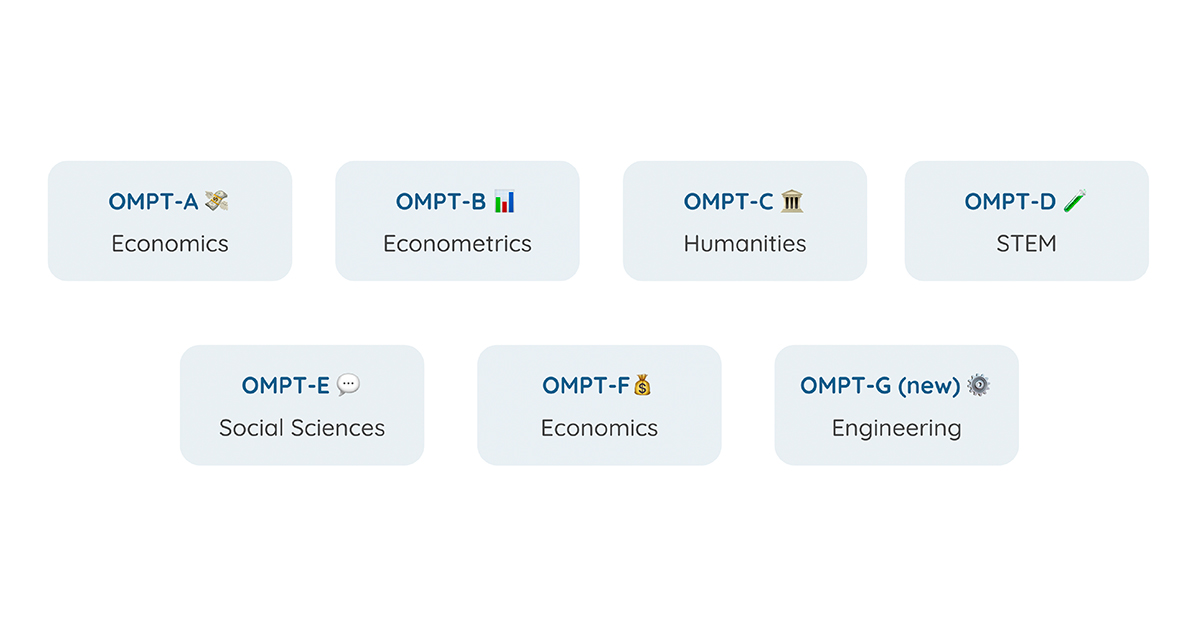
Regular updates are made to the exams for security and effectiveness reasons, ensuring a clear student baseline. The test results provide a breakdown of student performance across various topics, giving a comprehensive view of the competency level of incoming students. This helps you make informed decisions, and we also flag applicants who have not entirely met the acceptance threshold but may still be considered.
The institutions we work with have successfully minimised dropout rates by not admitting students based on equivalency alone. This approach can be particularly beneficial if you aim to be responsive to changes in curricula, disruptions such as the pandemic, or changes in demographics that increase the importance of new, less understood markets.
Learn more about how OMPT lowers your dropout rate
OMPT offers high-quality practice materials and mock exams tailored to the test they’ll be taking. These resources help students learn independently, regardless of their background or access to private tutoring.
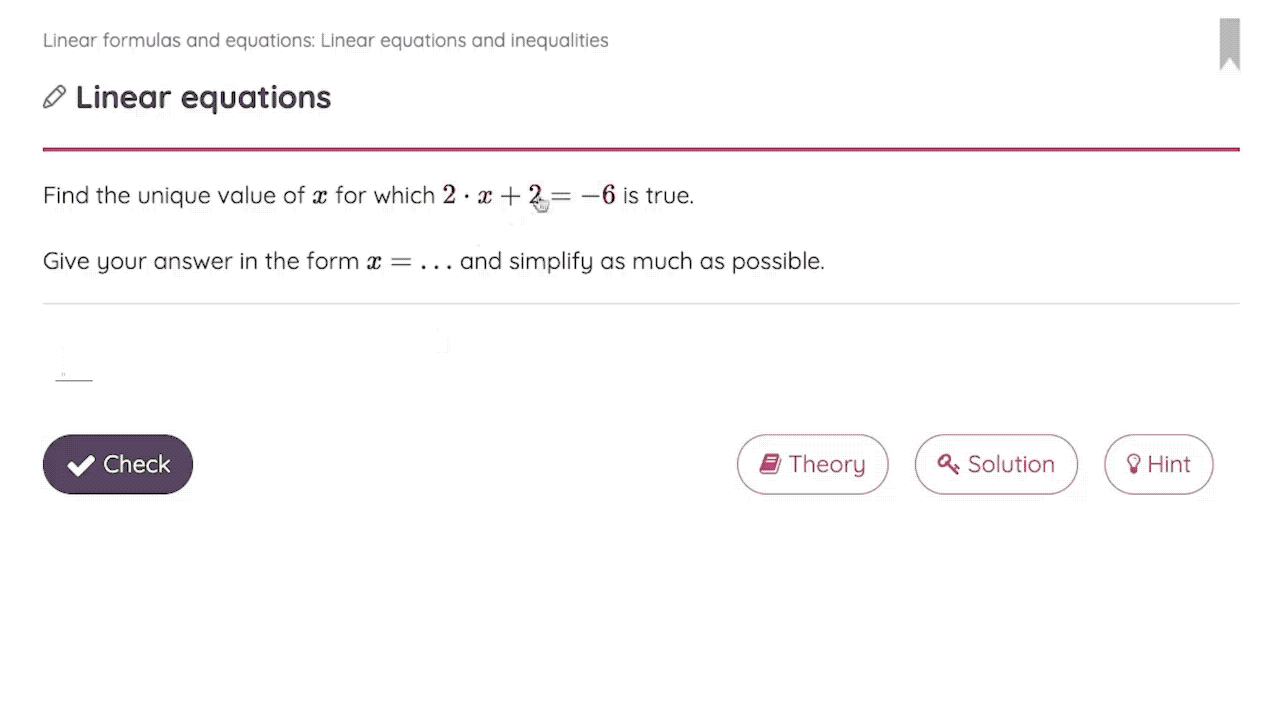
Our learning environment has won multiple awards for its ability to analyse students’ answer attempts and identify their mistakes. Based on this analysis, the platform automatically provides hints specific to each student’s learning path.
Our mathematics education experts create the practice materials used by leading institutions such as the University of Exeter, Penn State University, Rotterdam School of Management, and the University of Western Australia.
The OMPT platform is designed with the latest accessibility standards, including integrated text-to-speech and colour-blindness usability. Students with special needs can receive specific accommodations on the final test, such as extra time.
But what do the students think? Our 2021-2022 satisfaction survey received great feedback, with over 75% of test-takers saying they would recommend the OMPT exam to future university applicants. Additionally, over 80% of applicants stated that they are likely or very likely to recommend the practice material to prospective test-takers. Now, let’s see how OMPT works in practice.
Amsterdam University College (AUC) is a highly selective institution that offers an interdisciplinary Bachelor’s degree in Liberal Arts and Sciences in partnership with the University of Amsterdam and the Vrije University Amsterdam. Kasia Malarek (Admissions Officer and Lecturer at AUC) shared her story here.
AUC offers a unique program that gives students the freedom to choose from three majors: Sciences, Social Sciences, and Humanities. Each major has specific maths requirements.
AUC has applicants from 45 countries. However, assessing the mathematical abilities of candidates from diverse backgrounds and educational systems can be complicated due to differences in curricula, grading, and assessment methods across countries. This can be particularly time-consuming when dealing with less-known educational systems whose maths programs cannot be easily evaluated. This issue was present before the implementation of OMPT, as Kasia explains:
“We tried to understand the educational system we were working with. This takes a lot of work and changes yearly. So, it was tough to compare the maths programs. We looked at the curricula, the grade distribution and the available information. But we have learned over the years that that is not enough because these differences not only consist of differences in material or assessment methods but also in how students use these skills.”
Therefore, AUC sought a fair and sturdy solution for their admissions selection process.

To tackle this challenge, AUC has implemented the OMPT exams as a part of their admissions process. They use OMPT-A for Social Sciences, OMPT-B for Sciences, and OMPT-C for Humanities. Each exam specifically evaluates the maths skills necessary for the respective major. OMPT has several advantages, as explained by Kasia:
“What is great about these exams is that the applicant can take a test in the comfort of their own home. But also because it’s proctored, it assures our results are accurate.”
AUC encourages its students to use OMPT’s preparatory materials and mock exams to improve their maths proficiency and be well-prepared for their exams and future courses.
One notable aspect of AUC’s approach is that, for this academic year, they cover the cost of OMPT exams for their applicants, ensuring worldwide and fair access for candidates and relieving them from financial burden. Additionally, AUC allows candidates a maximum of two attempts to relieve pressure from the candidates and avoid assessing them based on a bad exam.
This solution saved AUC time assessing qualifications and provided a fair, transparent, and consistent method for evaluating maths readiness. In Kasia’s words:
“Now we can compare students from different educational systems that we don’t know much about. We can predict how well they will do in the program because, together with the results of the OMPT, you get more detailed information, showing how the candidate did in more particular aspects of the exam. So we have a great indication of the general and specific skills required to complete each major successfully”.Read full use case
Determining the suitability of applicants based on maths is not a straightforward process. It is vital to comprehend the purpose of the exams and qualifications and their varying assessment criteria in different countries. To make an accurate assessment, we need to consider multiple factors, such as the context of the qualification, the course content, the assessment method (internal or external), the different question types, and the assessment style.
Admissions officers put a lot of effort into their work. OMPT is a solution that can help admissions offices save time and widen access to applicants while ensuring maths readiness for selected students. This test provider allows students to demonstrate their mathematical proficiency from anywhere and anytime while reducing fraud with online proctoring. These digital maths admission exams have been proven to reduce dropout rates, especially for international students. Moreover, students gain access to practice materials and mock exams, increasing their chances of success.
Amsterdam University College receives applications from students from 45 different educational systems from around the world. As a result, the institution faces challenges in comparing mathematics programs due to the differences in the mathematical backgrounds of the applicants. To resolve this issue, OMPT supported the institution in building a robust, transparent, and fair maths assessment process. This approach enables the university to predict the performance of its students in their respective programs with greater accuracy.
Do you have any questions? Please feel free to reach out to info@omptest.org. If you are interested in the research part, get in touch with Ecctis at events@ecctis.com. We look forward to helping you!